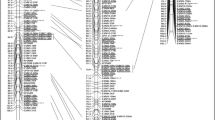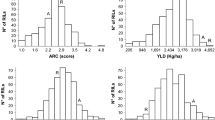Abstract
Genetic study on important traits of tea is difficult because of its self-incompatibility in nature. Moreover, development of a new variety usually needs more than 20 years, since it takes many years from seedling to matured plants for trait investigation. Genetic map is an essential tool for genetic study and breeding. In this study, we have developed an integrated genetic map of tea (Camellia sinensis) using a segregating F1 population derived from a cross between two commercial cultivars (‘TTES 19’ and ‘TTES 8’). A total of 574 polymorphic markers (including SSR, CAPS, STS, AFLP, ISSR and RAPD), 69 markers with highly significant levels of segregation distortion (P < 0.001) (12.0 %) were excluded from further analyses. Of the 505 mapped markers, there were 265 paternal markers (52.5 %), 163 maternal markers (32.3 %), 65 doubly heterozygous dominant markers (12.9 %), and 12 co-dominant markers (2.4 %). The co-dominant markers and doubly heterozygous dominant markers were used as bridge loci for the integration of the paternal and maternal maps. The integrated map comprised 367 linked markers, including 36 SSR, 3 CAPS, 1 STS, 250 AFLP, 13 ISSR and 64 RAPD that were assigned to 18 linkage groups. The linkage groups represented a total map length of 4482.9 cM with a map density of 12.2 cM. This genetic map has the highest genetic coverage so far, which could be applied to comparative mapping, QTL mapping and marker assisted selection in the future.



Similar content being viewed by others
Abbreviations
- MAS:
-
Marker-assisted selection
- QTL:
-
Quantitative trait loci
- SSR:
-
Simple sequence repeats or microsatellites
- CAPS:
-
Cleaved amplified polymorphic sequence
- PCR-RFLP:
-
Polymerase chain reaction-restriction fragment length polymorphism
- STS:
-
Sequence tagged site
- EST:
-
Expressed sequence tag
- LG:
-
Linkage groups
- cM:
-
centiMorgan
References
Ahn S, Tanksley SD (1993) Comparative linkage maps of the rice and maize genomes. Proc Natl Acad Sci USA 90:7980–7984
Barua PK (1963) Classification of the tea plant. Two Bud 10:3–11
Chen L, Yamaguchi S, Wang PS, Xu M, Song WX, Tong QQ (2002) Genetic polymorphism and molecular phylogeny analysis of section Thea based on RAPD markers. J Tea Sci 22:19–24
Chen L, Zhou ZX, Yang YJ (2007) Genetic improvement and breeding of tea plant (Camellia sinensis) in China: from individual selection to hybridization and molecular breeding. Euphytica 154:239–248
Cloutier S, Cappadocia M, Landry BS (1997) Analysis of RFLP mapping inaccuracy in Brassica napus L. Theor Appl Genet 95:83–91
Collard BCY, Jahufer MZZ, Brouwer JB, Pang ECK (2005) An introduction to markers, quantitative trait loci (QTL) mapping and marker-assisted selection for crop improvement: the basic concepts. Euphytica 142:169–196
Doyle JJ, Doyle JL (1990) Isolation of plant DNA from fresh tissue. Focus 12:13–15
Freeman S, West J, James C, Lea V, Mayes S (2004) Isolation and characterization of highly polymorphic microsatellites in tea (Camellia sinensis). Mol Ecol Notes 4:324–326
Grattapaglia D, Sederoff R (1994) Genetic linkage maps of Eucalyptus grandis and Eucalyptus urophylla using a pseudo-testcross: mapping strategy and RAPD markers. Genetics 137:1121–1137
Hackett CA, Wachira FN, Paul S, Powell W, Waugh R (2000) Construction of a genetic linkage map for Camellia sinensis (tea). Heredity 85:346–355
Haldane JBS (1919) The combination of linkage values, and the calculation of distances between loci of linked factors. J Genet 8:299–309
Hu CY, Tsai YZ, Lin SF (2005) Using ISSR DNA markers to evaluate genetic diversity of tea germplasm in Taiwan. J Agri Assoc China 6:463–480
Hu CY, Lin YC, Hsieh WT, Tseng YH, Lin SF, Tsai YZ (2011) Using EST-SSR markers to identify tea (Camellia sinensis) cultivars in Taiwan. Taiwan Tea Res Bull 30:9–22
Huang JA (2004) Construction of molecular genetic map and studies on the SNP of polyphenol oxidase gene in tea plant. Huana Agriculture University, Changsha
Huang JA, Li JX, Huang YH, Luo JW, Gong ZH, Liu ZH (2005) Construction of AFLP molecular markers linkage map in tea plant. J Tea Sci 25:7–15
Huang FP, Liang YR, Lu JL, Chen RB (2006) Genetic mapping of first generation of backcross in tea by RAPD and ISSR markers. J Tea Sci 26:171–176
Husband BC, Schemske DW (1996) Evolution of magnitude and timing of inbreeding depression in plants. Evolution 50:554–570
Jansen J (2005) Construction of linkage maps in full-sib families of diploid outbreeding species by minimizing the number of recombinations in hidden inheritance vectors. Genetics 170:2013–2025
Jansen J, de Jong AG, van Ooijen JW (2001) Constructing dense genetic linkage maps. Theor Appl Genet 102:1113–1122
Jenczewski E, Gherardi M, Bonnin I, Prosperi JM, Olivieri I, Huguet T (1997) Insight on segregation distortions in two intraspecific crosses between annual species of Medicago (Leguminosae). Theor Appl Genet 94:682–691
Jin JQ, Cui HR, Chen WY, Lu MZ, Yao YL, Xin Y, Gong XC (2006) Data mining for SSRs in ESTs and development of EST-SSR markers in tea plant (Cameelia sinensis). J Tea Sci 26:17–23
Kaundun SS, Matsumoto S (2004) PCR-based amplicon length polymorphisms (ALPs) at microsatellite loci and indels from non-coding DNA regions of cloned genes as a means of authenticating commercial Japanese green teas. J Sci Food Agric 84:895–902
Kesseli RV, Parant PI, Michelmore RW (1994) Analysis of a detailed genetic linkage map of Lactuca sativa (Lettuce) constructed from RFLP and RAPD markers. Genetics 134:1435–1446
Knott SA, Haley CS (1992) Maximum-likelihood mapping of quantitative trait loci using full-sib families. Genetics 132:1211–1222
Kosambi DD (1944) The estimation of map distances from recombination values. Ann Hum Genet 12:172–175
Lashermes P, Combes MC, Prakash NS, Trouslot P, Lorieux M, Charrier A (2001) Genetic linkage map of Coffea canephora: effect of segregation distortion and analysis of recombination rate in male and female meioses. Genome 44:589–596
Liu B (2009) Application studies of EST-SSR and ISSR markers in tea germplasms (Camellia spp.) from Yunnan. Tea science. Chin Academy of Agricultural Sciences, Zhejiang
Lu Q, Cui Y, Wu R (2004) A multilocus likelihood approach to joint modeling of linkage, parental diplotype and gene order in a full-sib family. BMC Genetics 5:20
Maliepaard C, Jansen J, Van Ooijen JW (1997) Linkage analysis in a full-sib family of an outbreeding species: overview and consequences for applications. Genet Res 70:237–250
Maliepaard C, Alston FH, van Arkel G, Brown LM, Chevreau E, Dunemann F, Evans KM, Gardiner S, Guilford P, van Heusden AW, Janse J, Laurens F, Lynn JR, Manganaris AG, den Nijs APM, Periam N, Rikkerink E, Roche P, Ryder C, Sansavini S, Schmidt H, Tartarini S, Verhaegh JJ, Vrielink-van Ginkel M, King GJ (1998) Aligning male and female linkage maps of apple (Malus pumila Mill.) using multi-allelic markers. Theor Appl Genet 97:60–73
Mewan KM, Saha MC, Konstantin C (2007) Construction of a genomic and EST-SSR based saturated genetic linkage map of tea (Camellia sinensis L.). In: Proceedings of the 3rd international conference on O-Cha (tea) culture and science (ICOS), Shizuoka, Japan
Mondal TK, Chand PK (2002) Detection of genetic variation among micropropagated tea [Camellia sinensis (L). O. Kuntze] by RAPD analysis. In Vitro Cell Dev Biol: Plant 38:296–299
Paglia P, Olivieri AM, Morgante M (1998) Towards second-generation STS (sequence-tagged sites) linkage maps in conifers: a genetic map of Norway spruce (Picea abies K.). Mol Gen Genet 258:466–478
Perfectti F, Pascual L (1996) Segregation distortion of isozyme loci in cherimoya (Annona cherimola Mill). Theor Appl Genet 93:440–446
Rieseberg LH (1998) Genetic mapping as a tool for studying speciation. In: Soltis DE, Soltis PS, Doyle JJ (eds) Molecular systematics of plants II. Kluwer, London, pp 459–487
Rogers S (1975) Observations on pollen tube compatibility in tea clones. Tea Quart 45:91–100
Sharma RK, Bhardwaj P, Negi R, Mohapatra T, Ahuja PS (2009) Identification, characterization and utilization of unigene derived microsatellite markers in tea (Camellia sinensis L.). BMC Plant Biol 11:9–53
Shyu YS, Juan IM (1993) Retrospect of tea breeding in Taiwan. Taiwan Tea Res Bull 12:1–17
Takeo T (1992) Green and semi-fermented teas. In: Willson KC, Clifford MN (eds) Tea: cultivation to consumption. Chapman & Hall Press, London, pp 413–457
Tan YP (2007) The establishment of SSR molecular marker method in tea plant [Camellia sinensis ((L.) 0. Kuntze] and its application. Huana Agricultural University, Changsha
Tanaka J (1996) The possibility of using RAPD analysis to create genetic map of tea. Tea Res J 84:44–45
Taniguchi F, Tanaka J, Kono I (2007) Construction of genetic linkage map of tea using SSR markers. In: Proceedings of the 3rd International Conference on O-Cha (tea) Culture and Science (ICOS), Shizuoka, Japan
Tsai HT, Tsai IC, Liaw WR, Chang CK, Wang YW (2003) Study on the genetic diversity among the selected Taiwan tea cultivars/lines using AFLP and RAPD markers. Taiwan Tea Res Bull 22:17–32
Tsai CM, Chang CK, Chen IZ, Chen KR, Tsai YZ, Chiou CF, Lin IC, Fan HJ (2004) Breeding report of two 2004 registered new tea cultivar TTES No. 19 and 20. Taiwan Tea Res Bull 23:57–78
Ueno S, Yoshimaru H, Tomaru N, Yamamoto S (1999) Development and characterization of microsatellite markers in Camellia japonica L. Mol Ecol 8:335–346
Van Ooijen JW (2006) JoinMap 4, software for the calculation of genetic linkage maps in experimental populations. Kyazma B.V., Wageningen
Van Ooijen JW (2011) Multipoint maximum likelihood mapping in a full-sib family of an outbreeding species. Genet Res 93:343–349
Van Os H (2005) The construction of an ultra-dense genetic linkage map of potato. Wageningen University, The Netherlands
Virk PS, Ford-Lloyd BV, Newbury HJ (1998) Mapping AFLP markers associated with subspecific differentiation of Oryza sativa (rice) and an investigation of segregation distortion. Heredity 81:613–620
Wachira FN, Waugh R, Hackett CA, Powell W (1995) Detection of genetic diversity in tea (Camellia sinensis) using RAPD markers. Genome 38:201–210
Wang LY, Jiang YH, Duan YS, Cheng H, Zhou J, Zeng JM (2009) Characterization of EST-derived microsatellites and development of SSR-markers in Tea (Camellia sinensis). J Plant Genet Resour 10:511–516
Xu S, Hu Z (2009) Mapping quantitative trait loci using distorted markers. Int J Plant Genomics 2009:1–11
Zhao LP, Liu Z, Chen L, Yao MZ, Wang XC (2008) Generation and characterization of 24 novel EST derived microsatellites from tea plant (Camellia sinensis) and cross-species amplification in its closely related species and varieties. Conserv Genet 9:1327–1331
Acknowledgments
The authors would like to thank Dr. Kai-Yi Chen of the Department of Agronomy, National Taiwan University in Taiwan for his kind assistance in providing us with the software JoinMap® v4.1.
Author information
Authors and Affiliations
Corresponding author
Electronic supplementary material
Below is the link to the electronic supplementary material.
Rights and permissions
About this article
Cite this article
Hu, CY., Lee, TC., Tsai, HT. et al. Construction of an integrated genetic map based on maternal and paternal lineages of tea (Camellia sinensis). Euphytica 191, 141–152 (2013). https://doi.org/10.1007/s10681-013-0908-0
Received:
Accepted:
Published:
Issue Date:
DOI: https://doi.org/10.1007/s10681-013-0908-0




